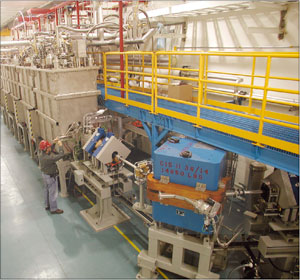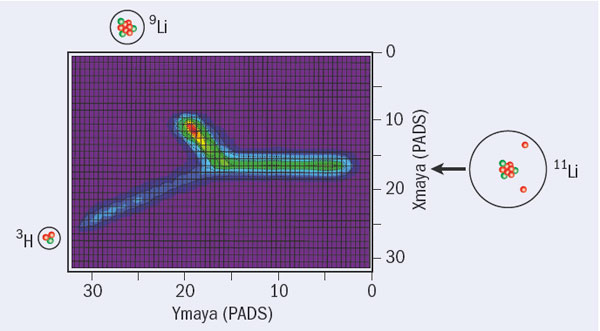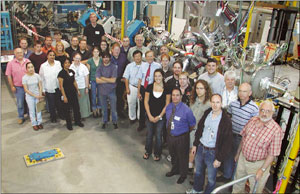The ISAC-II facility gets off to a good start with beams of rare isotopes.
Nuclear science is undergoing a renaissance driven, not by the printing press or a breakthrough in visual art, but by an increasingly powerful set of beams of rare isotopes. Several nations around the world are competing to obtain the most exotic isotopes, the most intense beams and the most versatile detectors in pursuit of this exciting science. TRIUMF, Canada’s National Laboratory for Particle and Nuclear Physics, has occupied a leading position in this race and has just taken a stride forward with the successful commissioning of its ISAC-II facility.

Image credit: TRIUMF.
New patterns in the organization within the nucleus, such as neutron halos, neutron skins and new magic numbers that appear only off the line of stability, are prompting new questions and bringing scientists closer to a systematic understanding of nuclear structure. In addition, the new experimental field of nuclear astrophysics has brought new emphasis to the importance of understanding the sophisticated reactions that potentially gave rise to all of the elements in our universe beyond iron. As a visitor to TRIUMF recently noted, “Nuclear astrophysics is invaluable because it helps us understand why gold is so rare!”
To explore this rich world of nuclei, TRIUMF has designed, built and commissioned the second phase of its Isotope Separator and Accelerator (ISAC) facility, ISAC-II, with support from the Government of Canada and the Province of British Columbia. The new facility includes a superconducting linear accelerator to boost the energies of the exotic, heavy isotopes over the Coulomb barrier. This is the energy threshold at which the nuclei have sufficient energy to come close enough to others in targets for the short-range strong interactions to take effect.
TRIUMF began developing superconducting acceleration technology in 2001 and is now a leader in the field, with a demonstrated accelerating gradient significantly above that of other operating facilities. The new superconducting beamline of ISAC-II adds 20 MV of accelerating voltage to the existing ISAC accelerator chain (figure 1). Robert Laxdal and his team at TRIUMF have developed the high-quality, low-emittance beams with high reliability that are strong features of the new facility.
Researchers have already begun to queue up to take advantage of the new beams. First in line was an experiment led by Hervé Savajols of the Grand Accelerateur National d’Ions Lourds (GANIL) in France and Tanihata from TRIUMF and Japan. They used the MAYA detector from GANIL to study the unusual structure of 11Li, which has as many as eight neutrons together with the three protons. When the first beams arrived on 5 January 2007 the experiment was ready within two hours and was taking data. For this experiment, only 11 of the 20 available superconducting niobium RF cavities were needed to accelerate the beam to the energy of 39.6 MeV required for the experiment.

11Li is an extreme example of a halo nucleus, where two of the neutrons couple together to form an extended outer “halo”, and the aim of this MAYA ISAC-II experiment was to study the pairing correlation between the two neutrons. Many of the two-neutron halo nuclei have an unusual structure and the correlation between two neutrons plays an important role in both the nuclear binding and structure. Although there have been several experiments to study the break up of the nucleus, the correlation between the two halo neutrons is still not well understood.
At ISAC-II, MAYA studied the two-neutron transfer reaction 11Li +p → 9Li +3H at a beam energy of 3.6A MeV (figure 2). This kind of reaction is believed to be the best tool for studying two-nucleon correlation in nuclei. ISAC-II delivered a stable 11Li beam with an intensity of about 2000 ions/s to MAYA’s active-target detector, in which isobutane gas of 150 mbar acts as both the proton target and tracking gas. A silicon-detector array and a caesium-iodide array within MAYA detected forward-going, high-energy particles that left the gas detection area. The active target provides almost 4π detection of the reaction, the thickest usable target, and an efficient detection of low-energy recoil particles. The experiment was performed by a collaboration between GANIL, the Argonne National Laboratory and TRIUMF.

Image credit: TRIUMF.
Later in 2007, the TRIUMF-ISAC Gamma-Ray Escape Suppressed Spectrometer (TIGRESS) augmented by the auxiliary charged-particle detector BAMBINO was used at ISAC-II to measure the electromagnetic properties of low-lying states in the neutron-rich unstable nucleus 29Na using the Coulomb-excitation technique. TIGRESS is a next generation array of high-energy-resolution, position-sensitive gamma-ray spectrometers (figure 3). BAMBINO is a segmented-silicon detector array, built by Lawrence Livermore National Laboratory (LLNL) and the University of Rochester. A team of scientists from TRIUMF, LLNL, the University of Guelph and 12 other institutions in Canada, the UK, and the US, collaborated on this measurement and were led by Ching-Yen Wu of LLNL.
For this experiment, minimizing the isobar contamination in the main exotic beam is a major challenge for the beam-delivery group. At the full capacity, up to 600 29Na ions per second were delivered at 70 MeV on a 110Pd target. The magnitude of the electromagnetic transition rate for the first excited state in 29Na, determined from this measurement, sheds light on the quenching of magic numbers in nuclei, which is crucial to our understanding of the effective nucleon–nucleon interaction in nuclear medium with extreme isospin. The final results will complement ongoing studies of similarly exotic systems such as 11Li and provide insight into the production of heavy elements in exploding stars. Project leader Carl Svensson of the University of Guelph was recently awarded the prestigious EWR Steacie Memorial Fellowship of the Natural Sciences and Engineering Research Council of Canada for his work on TIGRESS.
After the first season of success, TRIUMF is eager to press further forward. It plans to add a complementary electron driver to the ISAC programme as well as a new beamline for protons on an actinide target, which is currently being developed. The nuclear-physics renaissance is in full swing.








